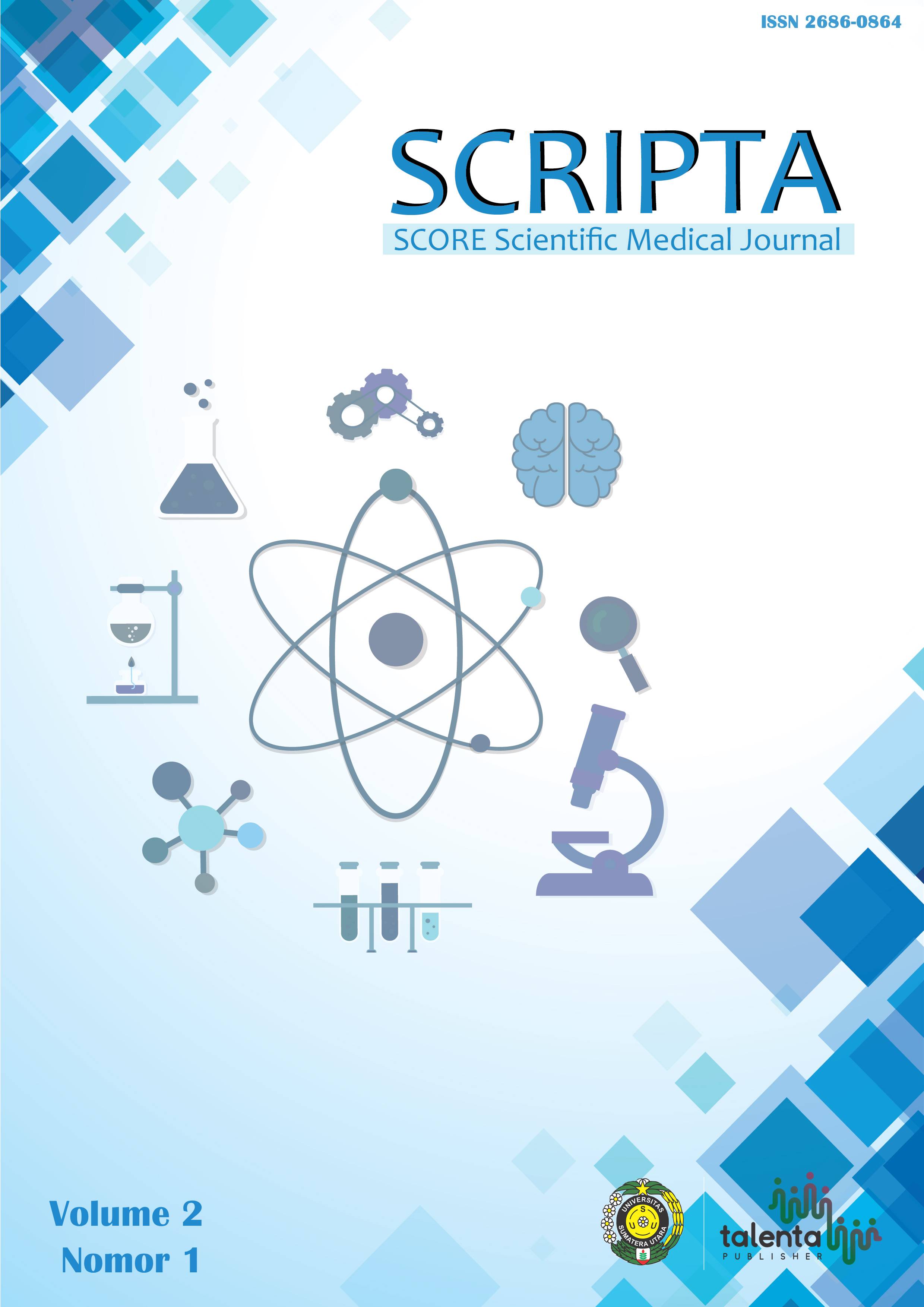Relationship of Histopathology Grading with Molecular Subtypes of Breast Cancer Patients in Haji Adam Malik General Hospital 2016-2018
DOI:
https://doi.org/10.32734/scripta.v2i1.3364Keywords:
breast cancer, histopathological grade, immunohistochemistry, molecular subtypes, grading histopatologi, immunohistokimia, kanker payudara, subtipe molekulerAbstract
Background: Breast cancer symptoms are often not felt clearly by patients, as a result many patients who come in an advanced stage. This will affect the prognosis and cure rate of the patient. There are several factors that influence the prognosis of breast cancer, including histopathological grade, and classic immunohistochemical markers such as estrogen receptors, progesterone receptors, and HER2. In addition, breast cancer can be 4 main molecular subtypes, namely Luminal A, Luminal B, HER2-Overexpression, and Triple Negative / Basal-Like.
Objectives: This study aims to determine the relationship between histopathological grade with the molecular subtypes of breast cancer patients in Haji Adam Malik General Hospital in 2016-2018.
Methods: This is analytical cross-sectional research using a consecutive-sampling technique. Data were obtained secondary from the medical records of breast cancer patients at Haji Adam Malik General Hospital in 2016-2018 and then analyzed with the chi-square test. From 1005 cases of breast cancer during the 2016-2018 period, 131 samples were taken in this study.
Results: Of the 131 samples, the highest histopathological grade was grade 2 with 53 people (40.5%), followed by 41 people (31.3%) with grade 3, and 37 people (28.2%) with grade 1. The most molecular subtypes were Luminal A with 38 people (29%), followed by 33 people (25.2%) with Luminal B, 31 people (23.7%) with HER-2 Overexpression, and 29 people (22.1%) with Triple Negative / Basal-like. From the analysis of the chi-square test obtained p value of 0.045.
Conclusion: There is a relationship between histopathological grade with molecular subtypes of breast cancer patients.
Keywords: breast cancer, histopathological grade, immunohistochemistry, molecular subtypes
Â
Â
Latar Belakang: Gejala-gejala kanker payudara sering tidak dirasakan dengan jelas oleh pasien, akibatnya banyak pasien yang datang dalam keadaan stadium lanjut. Hal ini akan mempengaruhi prognosis dan tingkat kesembuhan pasien. Terdapat beberapa faktor yang mempengaruhi prognosis dari kanker payudara, antara lain grading histopatologi, dan marker imunohistokimia klasik seperti reseptor estrogen, reseptor progesteron, dan HER2. Selain itu, kanker payudara dapat diklasifikasikan menjadi 4 subtipe molekuler utama, yaitu Luminal A, Luminal B, HER2-Overexpression, dan Triple Negative/Basal-Like.
Tujuan: Penelitian ini bertujuan untuk mengetahui hubungan antara grading histopatologi dengan subtipe molekuler pasien kanker payudara di RSUP Haji Adam Malik Tahun 2016-2018.
Metode: Penelitian ini merupakan penelitian analitik menggunakan desain cross-sectional dengan teknik pengambilan sampel consecutive-sampling. Data diperoleh secara sekunder dari rekam medis pasien kanker payudara di RSUP Haji Adam Malik pada tahun 2016-2018 dan kemudian dianalisis dengan uji chi-square. Dari 1005 kasus kanker payudara selama periode 2016-2018, diambil sampel pada penelitian ini sebanyak 131 buah rekam medis.
Hasil: Dari 131 sampel, grading histopatologi terbanyak terdapat pada grade 2 dengan 53 orang (40,5%) , diikuti 41 orang (31,3%) dengan grade 3, dan 37 orang (28,2%) dengan grade 1. Subtipe molekuler terbanyak yaitu Luminal A dengan 38 orang (29%), diikuti 33 orang (25,2%) dengan Luminal B, 31 orang (23,7%) dengan HER-2 Overexpression, dan 29 orang (22,1%) dengan Triple Negative/Basal-like. Dari hasil uji chi-square diperoleh nilai p sebesar 0,045.
Kesimpulan: Terdapat hubungan antara grading histopatologi dengan subtipe molekuler pasien kanker payudara.
Kata kunci: grading histopatologi, imunohistokimia, kanker payudara, subtipe molekuler
Downloads
Downloads
Published
How to Cite
Issue
Section
License
Copyright (c) 2020 Muhammad Furqan, Pimpin Utama Pohan

This work is licensed under a Creative Commons Attribution-ShareAlike 4.0 International License.
Authors who publish with SCRIPTA SCORE Scientific Medical Journal agree to the following terms:
- Authors retain copyright and grant SCRIPTA SCORE Scientific Medical Journal right of first publication with the work simultaneously licensed under a Creative Commons Attribution-NonCommercial License that allows others to remix, adapt, build upon the work non-commercially with an acknowledgment of the work’s authorship and initial publication in SCRIPTA SCORE Scientific Medical Journal.
- Authors are permitted to copy and redistribute the journal's published version of the work non-commercially (e.g., post it to an institutional repository or publish it in a book), with an acknowledgment of its initial publication in SCRIPTA SCORE Scientific Medical Journal.














